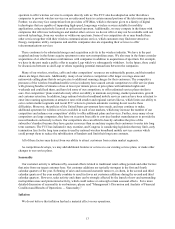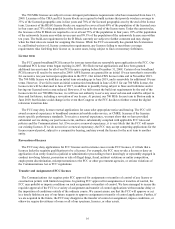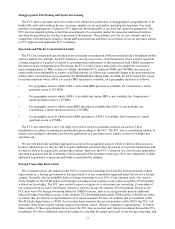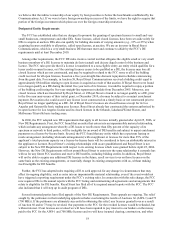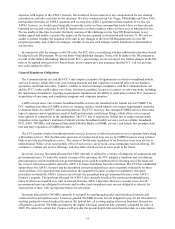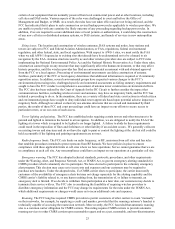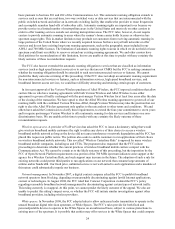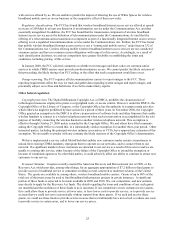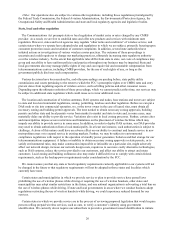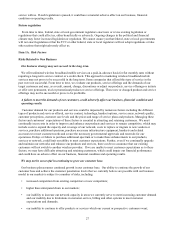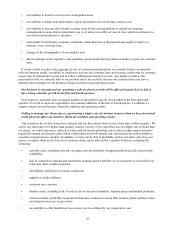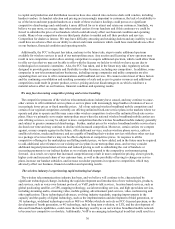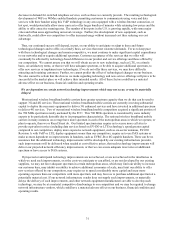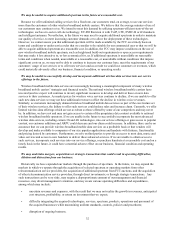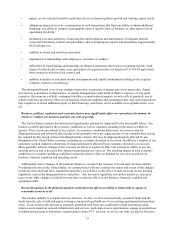Metro PCS 2008 Annual Report Download - page 32
Download and view the complete annual report
Please find page 32 of the 2008 Metro PCS annual report below. You can navigate through the pages in the report by either clicking on the pages listed below, or by using the keyword search tool below to find specific information within the annual report.23
certain of our equipment that are normally powered from local commercial power and at other locations, including
cell sites and DAS nodes. Various aspects of the rules were challenged in court and before the Office of
Management and Budget, or OMB. As a result, the rules have not taken effect and are not being enforced, and the
FCC has indicated that it plans to seek comment on revised backup power rules applicable to wireless providers. We
are unable to predict with any certainty the likely outcome of any proceeding regarding backup power rules. In
addition, if we are required to secure additional state or local permits or authorization, it could delay the construction
of any new cell sites or distributed antenna systems, or DAS systems, and launch of services in new metropolitan
areas.
Siting issues. The location and construction of wireless antennas, DAS systems and nodes, base stations and
towers are subject to FCC and Federal Aviation Administration, or FAA, regulations, federal environmental
regulation, and other federal, state, and local regulations. With respect to AWS-1 sites, we must notify the FAA
when we add AWS-1 frequencies to existing sites that already have been determined not to be a hazard to air
navigation by the FAA. Antenna structures used by us and other wireless providers also are subject to FCC rules
implementing the National Environmental Policy Act and the National Historic Preservation Act. Under these rules,
construction cannot begin on any structure that may significantly affect the human environment, or that may affect
historic properties, until the wireless provider has filed an environmental assessment with and obtained approval
from the FCC or a local agency. Processing of environmental assessments can delay construction of antenna
facilities, particularly if the FCC or local agency determines that additional information is required or if community
opposition arises. In addition, several environmental groups have requested various changes to the FCC’s
environmental processing rules, challenged specific environmental assessments as failing statutory requirements and
sought to have the FCC conduct a comprehensive assessment of antenna tower construction environmental effects.
The FCC also has been ordered by the Court of Appeals for the DC Circuit to further consider the impact that
communications facilities, including wireless towers and antennas, may have on migratory birds, and the FCC has
initiated a proceeding to do so. In the meantime, there are a variety of federal and state court actions in which citizen
and environmental groups have sought to deny individual tower approvals based upon potential adverse impacts to
migratory birds. Although we almost exclusively use antenna structures that are owned and maintained by third
parties, the results of these FCC and court proceedings could have an impact on our efforts to secure access to
particular towers, or on our costs of such access.
Tower lighting and painting. The FCC has established rules requiring certain towers and other structures to be
painted and lighted to minimize the hazard to air navigation. In addition, we are obligated to notify the FAA if the
lighting at a tower which is required to be lighted is no longer lighted. A failure to abide by these requirements
could result in the imposition of fines and forfeitures or other liability if an accident occurs. We generally collocate
on existing towers and structures and do not have the right to paint or control the lighting at the site but still could be
held accountable if the lighting and painting requirements are not met.
Radio frequency limits. The FCC sets limits on radio frequency, or RF, emissions from cell sites and has rules
that establish procedures intended to protect persons from RF hazards. We have policies in place to ensure
compliance with these applicable limits at cell sites where we have operations, but we cannot guarantee that we are
in compliance at each cell site. Any noncompliance could have an impact on our operations at a particular cell site.
Emergency warning. The FCC has adopted technical standards, protocols, procedures, and other requirements
under the Warning, Alert, and Response Network Act, or WARN Act, to govern emergency alerting standards for
CMRS providers which voluntarily elect to participate. We have elected to participate in the voluntary emergency
alert program. This election may cause us to incur costs and expenses and our customers may be required to
purchase new handsets. Under the adopted rules, if a CMRS carrier elects to participate, the carrier must notify
customers of the availability of emergency alerts but may not charge separately for the alerting capability and the
CMRS carrier’s liability related to, or any harm resulting from, the transmission of, or failure to transmit, an
emergency alert is limited. If we decide to withdraw from participation at a later date, our customers may decide to
terminate their service with us. The FCC also is considering the feasibility of requiring wireless providers to
distribute emergency information and the FCC may change its requirements for the rules under the WARN Act,
which additional requirements or changes would cause us to incur additional costs and expenses.
Roaming. The FCC long has required CMRS providers to permit customers of other carriers to roam “manually”
on their networks, for example, by supplying a credit card number, provided that the roaming customer’s handset is
technically capable of accessing the roamed-on network. More recently, the FCC has ruled that automatic roaming
also is a common carrier obligation for CMRS carriers. This ruling requires CMRS carriers to provide automatic
roaming services to other CMRS carriers upon reasonable request and on a just, reasonable, and non-discriminatory


